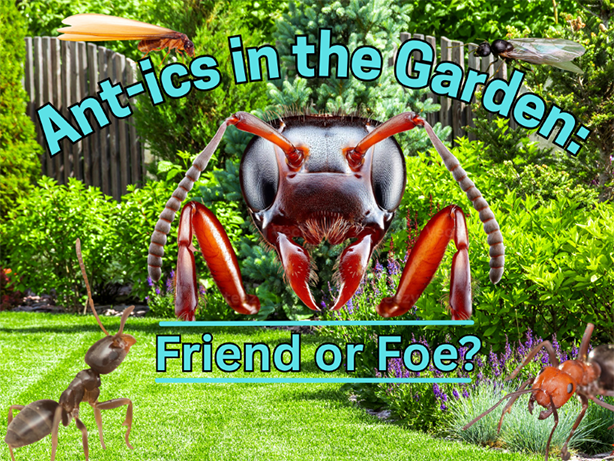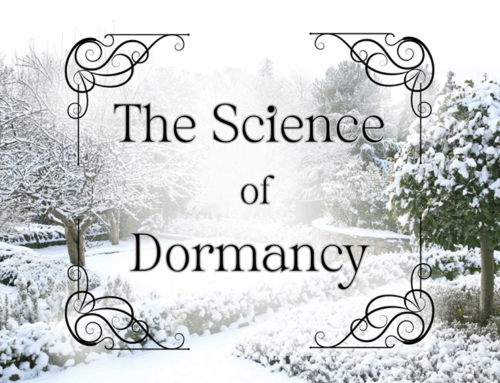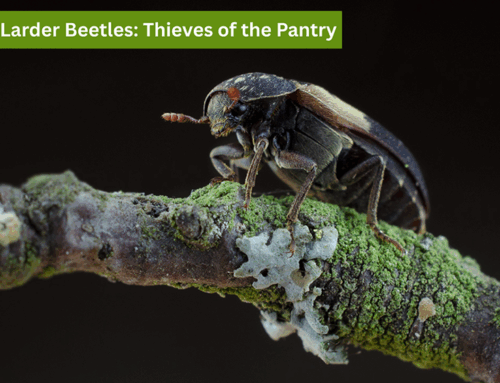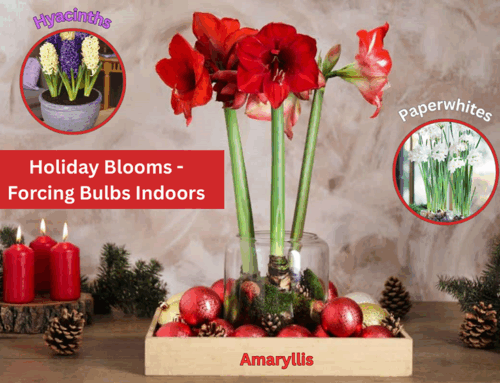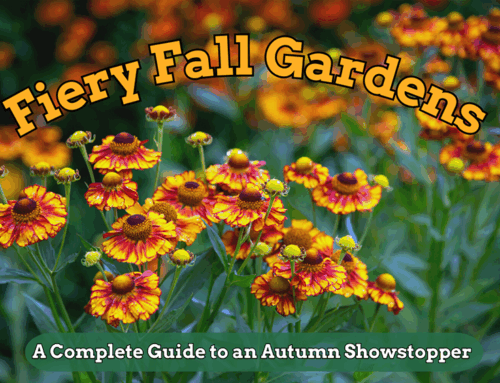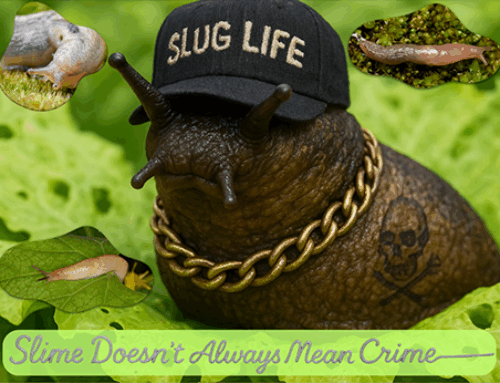Ants in the Garden: Friend or Foe?
by Brett Kerley
Ants are a familiar sight in Edmonton gardens, especially from May through September. With over 100 species in Alberta, they are more than just picnic invaders—they’re vital players in garden ecosystems. Yet, for all their industriousness, their habits don’t always align with a gardener’s goals. Some ants aerate soil and hunt pests, while others protect plant-damaging aphids or undermine root systems.
Understanding the roles ants play—and knowing when to intervene—can help you maintain balance in your garden and avoid turning a small problem into a full-blown infestation.
Why Are Ants Attracted to Our Gardens?
In our Zone 3b–4 climate, ants emerge rapidly in late spring and are especially active during warm, dry spells between June and August. Here’s what draws them in:
- Aphid Populations: Aphids and scale insects thrive in Edmonton’s dry summers. Ants are drawn to their sugary secretions (called honeydew), and some species actively “farm” aphids to harvest it.
- Mulch and Compost: Dry mulch—especially straw, bark, or wood chips—makes excellent nesting material. Ants also move into unturned compost piles, particularly if food scraps or fruit are left exposed.
- Wooden Structures: Older raised beds or untreated deck wood provide the perfect home for carpenter ants.
- Moisture Shelters: Shaded, dry ground under patios or paving stones is another favourite, especially for species like Pavement Ants or Field Ants.
Ants as Garden Allies
Ants aren’t all bad news. In fact, they bring several benefits to your Edmonton garden:
- Soil Aeration & Drainage: They dig deep tunnels that improve drainage and aerate heavy prairie soils, especially those containing clay.
- Natural Decomposers: They break down dead insects and organic material, recycling nutrients into your soil.
- Biological Pest Control: Some prey on harmful insects like caterpillars and mites.
- Seed Dispersers: Species in the Formica and Lasius genera collect and disperse seeds, increasing plant diversity.
- Microbial Influence: Their presence can even influence beneficial bacteria and fungi in the soil, contributing to plant health.
When Ants Become a Problem
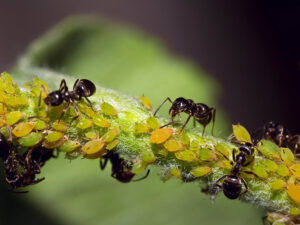
Ants have a symbiotic relationship with aphids
Despite their benefits, ants can cause issues in a garden:
- Aphid Farming: They protect aphids from predators to harvest their honeydew, resulting in aphid outbreaks that can damage plants.
- Soil & Root Disturbance: Some species, like Field and Thatching Ants, build large nests that disrupt root systems or create unsightly mounds.
- Damage to Structures: Carpenter ants don’t eat wood, but they hollow it out for nests, threatening raised beds, sheds, or retaining walls.
- Nuisance & Bites: While rare, some ants bite when disturbed. Odorous House Ants may enter homes, and their smell (like rotten coconut) can be unpleasant.
Common Edmonton Ant Species
Here are the species you’re most likely to spot:
- Pavement Ants (Tetramorium caespitum): Small and brown, often seen in cracks or garden beds.
- Carpenter Ants (Camponotus): Large and black, that tunnel into wood.
- Field Ants (Formica): Known for building visible soil mounds in lawns and garden beds.
- Thatching Ants (Formica obscuripes): Recognized by dome-shaped grass-and-needle nests.
- Odorous House Ants (Tapinoma sessile): Small and dark, with a distinctive odour.
- Cornfield or Turfgrass Ants (Lasius neoniger): Farm aphids underground and nest in sandy soil.
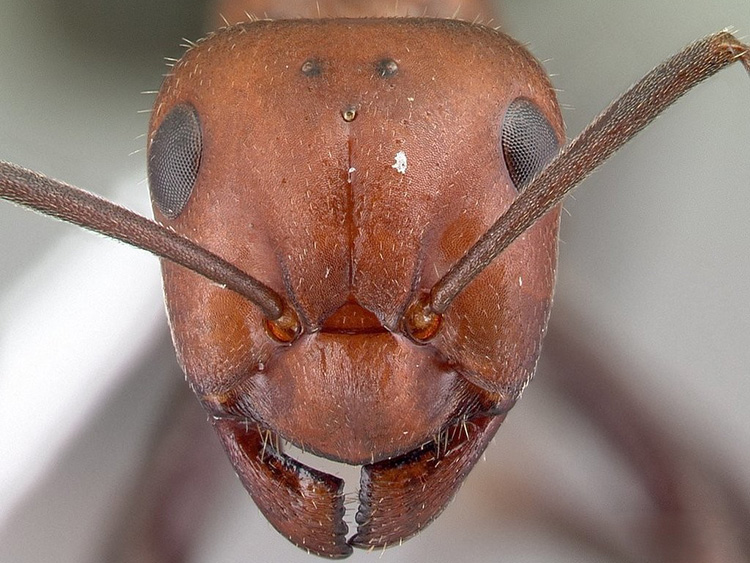
Thatching Ant (Formica obscuripes)
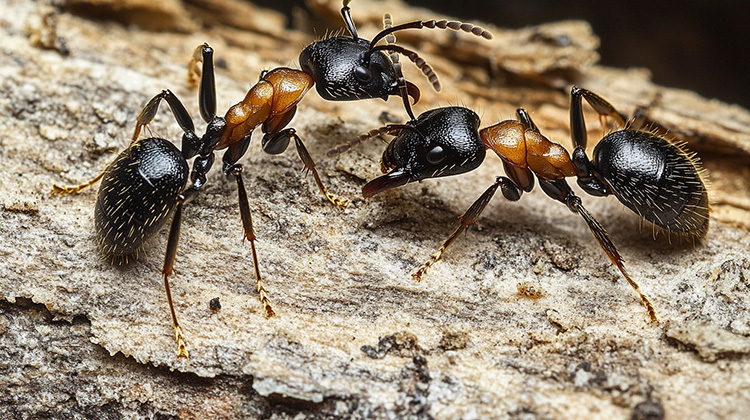
Carpenter Ants (Camponotus spp.)
Why Some Ants Fly: The Nuptial Flight
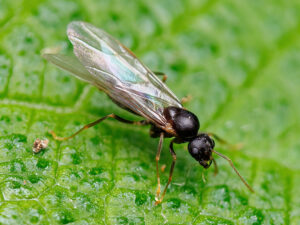
Flying Turfgrass Ant (Lasius neoniger)
Certain ants develop wings and take part in what’s called a nuptial flight. Here’s how it works:
- Winged ants—both males and virgin queens—emerge from the colony, often after warm weather and rainfall.
- They take to the air in large swarms (often from multiple colonies at once) to mate mid-flight.
- Once mated, male ants die shortly after.
- Fertilized female ants (future queens) land, shed their wings, and seek a good nesting spot to start a new colony.
This dramatic, once-a-year event is how ant colonies reproduce and spread. In Edmonton, you might see swarms of flying ants in July or August, especially during hot, humid evenings after rain. It might look like an infestation, but it’s just nature doing its thing.
The Ant Life Cycle
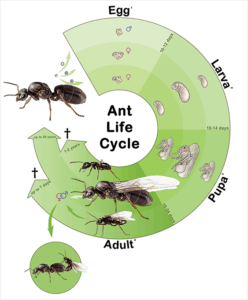
Ant Life Cycle
1. Egg
- Laid by the queen.
- Tiny, oval-shaped, and white or translucent.
- Fertilized eggs become females (workers or new queens); unfertilized eggs become males.
2. Larva
- Hatches from the egg after a few days.
- Looks like a small white grub.
- Fed and cared for by worker ants.
- Can’t move or feed itself.
3. Pupa
- After feeding, the larva spins a cocoon (in some species) or forms a naked pupa.
- During this stage, it transforms into its adult form (legs, antennae, eyes develop).
- Think of this like the “chrysalis” stage in butterflies.
4. Adult Ant
- Emerges as one of three types:
- Worker (female) – sterile, does all the colony work. Lives up to 2 years
- Queen (female) – reproductive, can live up to 30 years.
- Male (drone) – only lives to mate during nuptial flights, then dies. May live for a few weeks.
Estimated Timeline (Varies by Species & Temperature)
- Egg → Larva: 1–2 weeks
- Larva → Pupa: 1–2 weeks
- Pupa → Adult: 1–2 weeks
Total: About 4–6 weeks from egg to adult under ideal conditions.
Colony Growth
- Once a queen mates, she starts a new colony by:
- Digging a chamber.
- Laying her first eggs.
- Feeding the larvae from her fat stores and wing muscles.
- Once the first workers emerge, they take over all colony duties.
Signs You Have an Ant Issue
Watch for:
- Trails of ants on stems and branches (especially around aphids).
- Piles of fine soil or mounds at plant bases or between paving stones.
- Sticky residue (honeydew) on leaves, often accompanied by curled, yellowing foliage.
- Ants nesting in raised beds, cracks in patios, or wooden structures.
Natural Ant Control Strategies
1. Control Aphids First
Breaking the aphid–ant cycle early is key:
- Hose down soft-bodied plants (roses, beans, kale) in the morning with a strong spray.
- Use insecticidal soap or neem oil every 5–7 days.
- Attract aphid-eating predators like ladybugs, lacewings, and hoverflies by planting dill, yarrow, alyssum, and fennel.
Tip: In my old rose garden, aphids were a nightmare until I used the Borax sugar trap for ants and a daily hose jet for aphids. Once ladybugs moved in, nature took over.
2. Break Their Trails
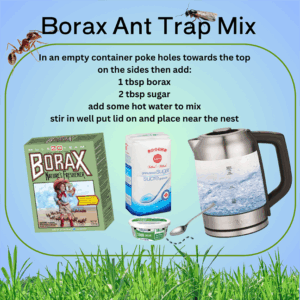
Borax Ant Trap Mix
Ants use scent (pheromones) to navigate. Disrupt them by:
- Sprinkling cinnamon, coffee grounds, or citrus peels along their paths.
- Spraying vinegar and water (1:1 ratio) along ant trails. Best used when dry weather is expected.
3. Use Physical Barriers
Prevent access to plants:
- Apply Tanglefoot (a sticky barrier) at the base of fruit trees or tall stems.
- Create moats or sprinkle diatomaceous earth (DE) around beds. It’s safe but deadly to ants. Reapply after rain. Apache Seed sells DE in bulk bags.
4. Eliminate Nests Safely
If you’ve located a nest, try:
- Boiling Water: A classic method my English grandmother swore by. Pour directly into the nest (avoid roots).
- Borax & Sugar Trap: Mix 1 tbsp Borax with 2 tbsp sugar and hot water. Place in a lidded sour cream container with holes poked near the top. The ants take the bait back to their colony, and within 24–48 hours, you’ll see results. Borax can be found in the laundry soap aisle.
- Flooding: Saturate the nest several times over a few days. Ants often move on if their nest remains damp.
Store-Bought Control Options
When natural methods don’t work:
- Terro Liquid Ant Bait or Raid Baits: Ants take poisoned bait back to the colony.
- Amdro Ant Block: Granules that kill foraging ants.
- Insecticidal Sprays: Use with caution and away from pollinator plants.
- Barrier Dusts or Sprays: Prevent ants from entering spaces but avoid contaminating edible plants or harming beneficial insects.
Note: Avoid broad-spectrum insecticides, which will also kill the pollinators and healthy soil life on which our gardens depend.
Long-Term Prevention
To keep ants from returning:
- Regularly turn and cover compost piles.
- Rake back mulch in early summer to check for signs of ant activity.
- Seal cracks in raised beds or upgrade to composite/metal frames.
Encourage predators—like birds, toads, garter snakes—by providing water, shelter, and native shrubs.
Final Thoughts
In Edmonton’s short but intense gardening season, ants can be both helpers and hindrances. Recognizing the difference—and responding early—lets you harness their benefits while minimizing their impact. With thoughtful, chemical-free strategies, you can keep your garden balanced, productive, and thriving from spring to fall.
Let’s give a little nod to the tiny tunnelers—see you in the garden!
Some photos used are from iNaturalist

